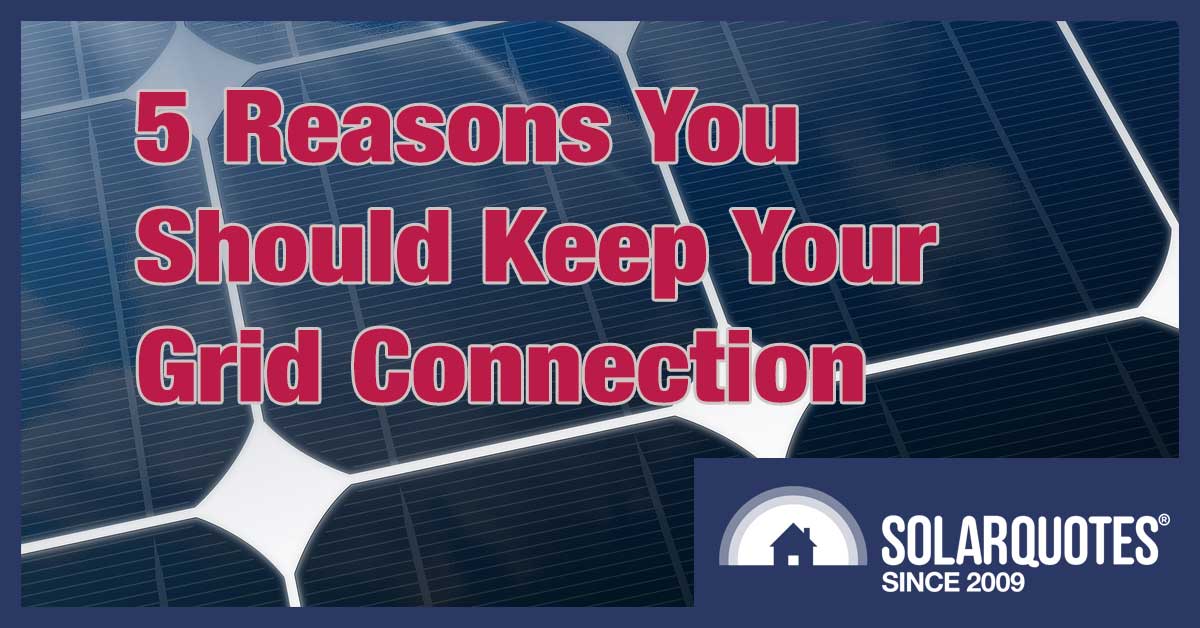
Yes, You Can Go Off-Grid With A $10,000 Battery — But I Don’t Recommend It
If you’re sick and tired of paying a supply charge to connect your solar home to the grid, then I have good news. You can now go off-grid with a battery system for around $10,000.
The bad news is, I don’t recommend it at all.
You may initially feel a surge of independence by cutting that cable. Or a surge of electricity if you use garden shears.
But expect to feel lousy before long because…
- Unless you’ve spent a lot of money — potentially over $50,000 for a family of four — an off-grid battery system will provide nothing close to the convenience of living on-grid.
- You can easily earn more receiving a solar feed-in tariff and potentially Virtual Power Plant (VPP) payments than you’ll pay in daily supply charges.
Going off-grid when you already have a grid connection is not only a costly and potentially uncomfortable choice, it’s also bad for the planet because…
- You can’t send surplus solar energy generation into the grid, where it will reduce fossil fuel generation.
Deciding to go off-grid can be a sound financial decision if you are building a home in a rural area where getting a grid connection will cost you an arm and a leg. But if power lines are running past your home, going off-grid doesn’t make financial or environmental sense.
5 Reasons To Stay On Grid
If you want energy independence, here are the 5 reasons you will be better off buying a solar battery and remaining on-grid.
- You will minimize your grid electricity use.
- You will have power when the grid fails.
- You can be prepared for the zombie apocalypse.
- You will be paid a solar feed-in tariff and potentially VPP payments
- You will reduce CO2 emissions that contribute to zombification.
Off-Grid With A $10,000 Solar Battery
If you want to go off-grid, around $10,000 is enough to do it. But that’s not nearly enough to have anything like the comfort and convenience of being on-grid.
When I say around $10,000 is enough, I’m not talking about a cheaply made box of lithium firecrackers I wouldn’t consider safe to install beside an asbestos igloo. Instead, I’m talking about a home battery with…
- A high level of safety.
- A warranty likely to last 10 years.
- Around 10 kilowatt-hours of usable storage when new.
- The ability to supply 5 kilowatts of continuous power.
A solar battery I wrote about recently that ticks these boxes is the Huawei Luna2000. It looks like this:
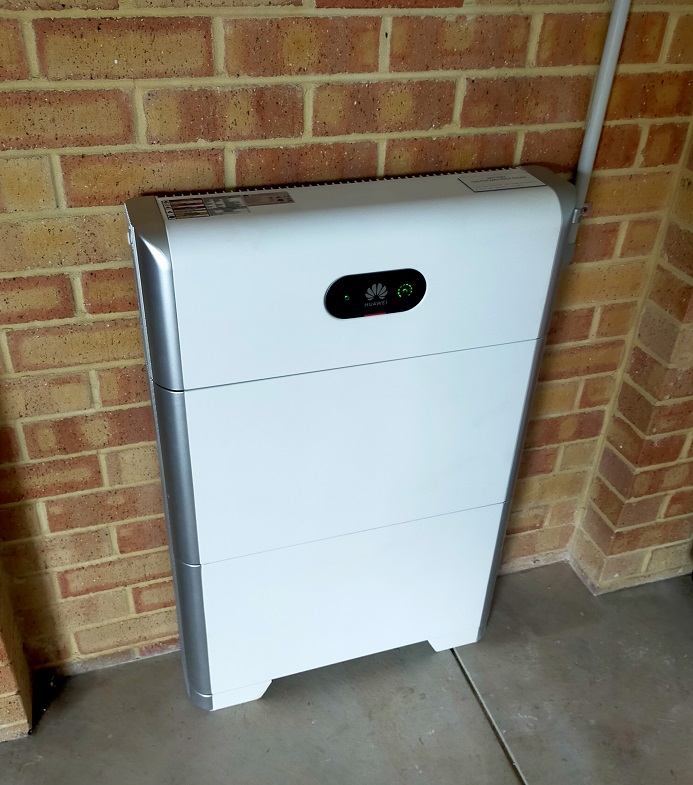
A 10 kilowatt-hour Huawei Luna2000 installation by Perth’s Solar4Ever. If you don’t need it to provide backup power, you can have this installed for under $10,000.
With the ability to operate off-grid, the 10 kilowatt-hour version has an installed cost of around $11,000. It has the drawback that you can only use it with a compatible Huawei inverter, but if you’re installing a solar power system and a battery simultaneously, it’s an option if you want to live the $11,000 off-grid battery dream/potential nightmare.
Only Energy-Stingy Can Live Off-Grid For $10,000
When I say living off-grid with a $10,000 home battery is a potential nightmare, I’m referring to normal people. If I was living by myself, I could easily get by. When I’m at home alone, I rarely use more than a few kilowatt-hours of grid electricity per day and rarely draw more than two kilowatts of power. I’m only ever likely to draw more than 5 kilowatts of power if I get carried away in the kitchen.
If I can get by on much less energy and power than the battery can provide, then you might think two energy frugal people could, but it doesn’t really work that way. Even with my energy-efficient lifestyle, I’ll need the extra capacity to get through periods of lean solar energy generation or unusually high consumption. With two people, the leeway is mostly lost.
There’s also increased potential for conflict. If I’m living off-grid alone and end up sitting in the dark because I stupidly drained the battery, I’ll only have myself to blame. But when there are two people, it’s easy for them to blame each other.
I advise never to try living off-grid with a $10,000 solar battery and your significant other unless you’re looking for a reason to break up. If you don’t believe it’s a bad idea, I can show you scar tissue I received when I caused my partner to lose all her energy in a computer game.
Off-Grid Comfort Is Costly
There’s no hard and fast rule for how much you’ll need to pay for an off-grid system that provides a level of comfort and convenience approaching being on-grid. It will depend on the location, how many are in the household, and energy consumption habits. But be prepared to pay over $50,000 for a family of 4 or 5. Adding the cost of solar power to that can easily take the total cost over $60,000.
Some families may be able to live comfortably with a solar and battery system that costs half that, but you’d want to be very confident its limitations won’t drive your family nuts.
There may be people currently living off-grid with six solar panels and four lead-acid batteries scoffing at the idea that $30,000 isn’t more than enough, but I’m talking about people who have lived their lives with the convenience of having grid power available at the flick of a switch 24/7 — or the 23.99/7 the grid actually manages.
You Save More On-Grid Than Off
Let’s say you’ve bought a battery system big enough to take your home off-grid. Or maybe you didn’t buy it. Perhaps you won it in a raffle. Regardless of whether you paid for your solar battery or received it for free, you’ll nearly always be better off staying on-grid. This is because…
- If your home battery system breaks down or runs out of charge, you can use grid power. This is cheaper than running a generator, as well as cleaner and quieter.
- You can receive a feed-in tariff by sending your surplus solar energy into the grid; while if you’re off-grid, any surplus goes to waste.
- If you are on-grid, you can receive payments by joining a VPP.
I don’t have a great opinion of VPPs in general. It’s complicated for homeowners to determine which one is best for them, and VPP providers can take advantage of consumer confusion to offer lousy deals. But even if, after accounting for drawbacks such as additional wear and tear on your battery, joining a VPP only offers $200 of net benefit a year – that’s still enough to improve the economics of staying on-grid significantly.
The supply charge to remain connected to the grid varies depending on location and electricity plan, but $1 a day is typical. On the graph below, I’ve shown how saving $365 a year on supply charges compares to how much a typical home with a battery and 6.6 kilowatt solar system can make by remaining on-grid under four different conditions:
As shown by the pink bar, annual payments from a 5 cent solar feed-in tariff nearly equal the annual supply charge cost. In this situation, the home would effectively be paying $27 a year for the benefit of being able to draw grid energy if required. A worthwhile price to pay to know you’ll have electricity no matter what problems your battery system may have.
With a 10 cent solar feed-in tariff or 5 cent feed-in tariff and a VPP payment, staying on-grid is clearly a better financial deal even if — very stupidly — zero value is placed on using grid electricity.
The above graph understates the advantages of remaining on-grid because most homes capable of going off-grid will have more than 6.6 kilowatts of solar panels and will receive more in solar feed-in tariff payments.
Remaining On-Grid Cuts Emissions
For every kilowatt-hour it supplies, the Australian grid currently emits around 650 grams of CO2. That is a little better than Poland at 724 grams and puts us neck and neck with Estonia — the only country in the world using Soviet technology to generate electricity from oil shale. But this figure only covers emissions from power stations. Additional emissions from the extraction and transportation of fossil fuels may push the actual figure closer to 700 grams.
This level of emissions is lousy for a country with…
- Abundant renewable resources.
- Aging1, unreliable, coal power stations that — in my opinion — aren’t worth repairing after parts of them explode.
Australia’s coal power stations are so old, I want to quote Leo Amery2 at them:
“You have sat too long here for any good you have been doing. In the name of God, go!”
Fortunately, emissions from generation are better than they were. In 2000 around 80% of our electricity came from coal, now it’s down to 62%. A major contributor to coal’s decline has been Australian households installing rooftop solar panels, which now supply 7.5% of electricity consumed on-grid. But if you take your home off-grid, then you can’t send the surplus energy generation your solar system produces into the grid to reduce fossil fuel generation.
If your home can go off-grid, it will produce surplus solar energy. This is because there are only two types of off-grid homes:
- Those that generate plenty of surplus solar energy, and…
- Those that spend plenty of time running a generator.
A typical, north-facing, 6.6 kilowatt solar system in Australia will generate around 9,600 kilowatt-hours a year. If the household consumes 5,000 kilowatt-hours of that solar energy, then 4,600 are exported to the grid. Using the 650 grams per kilowatt-hour figure will reduce CO2 emissions by around 3 tonnes a year — more than the annual emissions of the average Australian passenger car.
But reductions in emissions from sending solar energy into the grid will be even higher. It rarely displaces generation from other clean sources such as wind, hydro, or utility-scale solar power. Instead, it normally reduces fossil fuel generation. This makes the CO2 reduction from rooftop solar exports around 1 kg per kilowatt-hour.
The graph below shows the additional reduction in CO2 emissions resulting from a home with a 6.6 kilowatt solar power system deciding to remain on-grid rather than go off-grid and exporting an average of 4,500 kilowatt-hours:
Over 10 years, that comes to 45 tonnes. In most cases, emission reductions will be more than this because most homes will need more than 6.6 kilowatts of solar to go off-grid.
Going Off-Grid Is Not Worthwhile
Whether you care about saving money, saving the planet, or saving until you have a pile of money the size of a planet, buying a home battery and taking your home off-grid won’t help with any of those goals.
But I want to clarify that I’m not saying give up on any dreams you may have of independence by buying a solar battery. Instead, you can reduce your dependence on grid energy and have power when the grid fails while remaining on-grid.
Footnotes
- Some coal power station ages: Bayswater 37, Earing 40, Callide 57, Gladstone 46, Loy Yang 37, Tarong 36, Yallorn 37-48. ↩
- I original said the quote was from Winston Churchhill. It was not. I did check the internet to make sure it was a Churchill quote but I forgot that in addition to being the repository of all human knowledge it’s also the suppository of all human stupidity. ↩


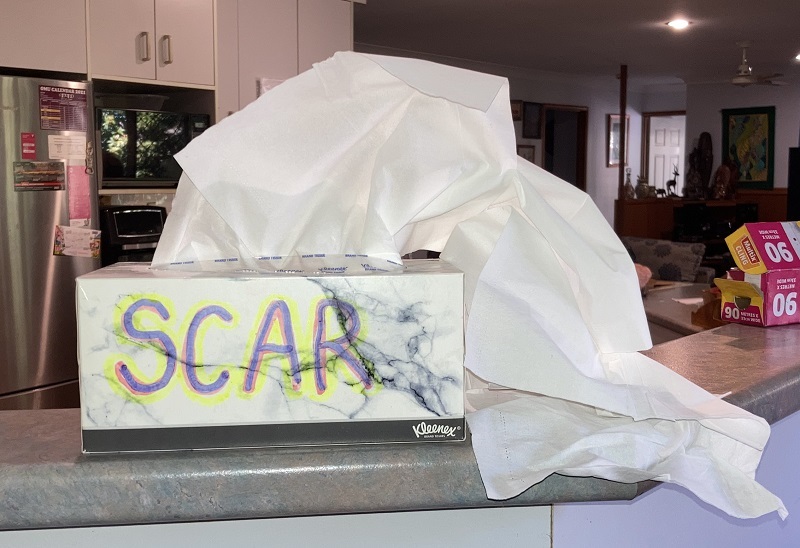
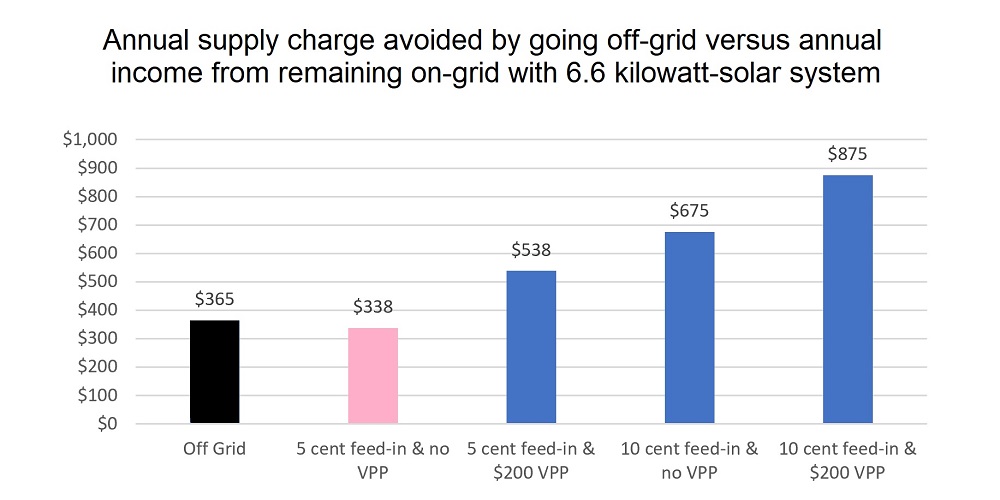
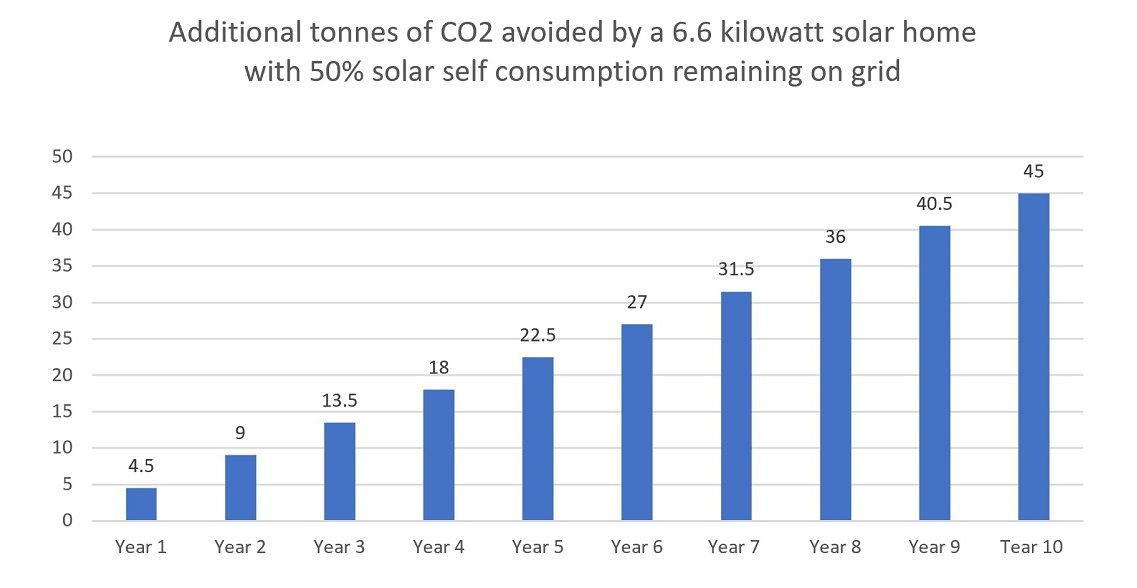
 RSS - Posts
RSS - Posts



Excellent overview, thanks for the analysis. I have some colleagues who are starry-eyed about big batteries and solar at our holiday house, used by our groups about ten weekends a year. On a swer line no less! Party weekends use about 100 kWh. And the battery would cost??? Please don’t calculate it, I’ve done the sums already.
A pensioners gem in Melbourne when you have concessions and have Solar and batteries, in the Summer months we enjoy about 60% discount on our supply charge because our imports are less than the supply charge.
Surprise surprise, I’m going to play devil’s advocate. : )
Very few people are looking to go off-grid right now, and as much as I warn about folk cutting the cord, I’m hoping it won’t happen for another 5-10 years.
$50K for a family of 4 seems a little high, but I guess if you live in an energy inefficient home and have a high energy use lifestyle it is plausible – at least so long as battery costs remain high.
For now FiTs easily cover usage and supply charges – assuming you have a large system, don’t use too much power, and are on a plan offering a decent rate, but FiTs are dropping fast, plus there’s the looming Solar Tax threat – details still unclear.
Regarding the 5 reasons to stay on grid, #1 and #4 are certainly true, #5 depends on your personal beliefs. #2 & #3 however are system dependent. Correct me if I’m mistaken but isn’t that primarily true only for single phase i.e. 5kW or less, systems? My understanding is that triple phase systems are either far harder to zombie apocalypse proof, or vastly more expensive – yes I could just have failed to keep up with the latest info but if I’m grossly mistaken then someone here please point me at the relevant SQ article or edumacate me. : )
$10K for a decent battery allowing you to go off-grid? That should easily cover dusk-dawn power consumption, plus daytime spikes – unless you empty the water tank after dark, and run the AC all night. The issue is when there’s a couple of days of really really bad solar in a row which doesn’t cover your usage let alone recharge your battery. What does a diesel generator run to?
Am I abnormal? My daily power use last month just squeaked into the double figures – half of which was covered by solar production, and I’m hoping this month is lower. Given the jug spikes power usage above 2kW, and the hot water tank draws 3-4kW, there are times of day when solar production simply isn’t sufficient without either a grid or a battery.
As regards squabbles over who flatlined the battery causing a loss of power in the middle of a computer game (Sacrilege, Blasphemy, Slay the Infidel! Er sorry slightly carried away there), wouldn’t battery monitoring make that an avoidable issue? Or do batteries not have the same monitoring ability as inverters?
$1 a day typical for supply charge? Is this for solar or non-solar plans? A Canstar Blue article from last month has New South Wales averaging 77.32c/day and Victoria 103.18c/day however my solar plan is charging 111.5c/day for supply plus 6.7c/day for solar, and somewhere I heard about $1.74 being charged per day for supply – though I can’t think where offhand. Thus my base charge is about 20% above the given typical figure. And if you have multiple supply charges, and\or power companies start trying to make their money off supply charges rather than usage charges like the water companies are …
My installer quoted it as 0.82 kg CO2 / kWh not 650g CO2 / kWh but frankly I’m one of those worried by the economic ramifications of climate change proposals, not the alleged damage of plant food emissions. Thus it naturally follows that should the cost of having a solar system connected to the grid exceed the financial benefit, it’s cord cutting time. Sure subsidising the grid might provide solace for the climate fundamentalists but I’m not one of them. Oh as an FYI apparently I’ve ‘avoided 5t of CO2’ with my solar, the year’s far from over, and I should hit 10t or better by the end of it, but frankly who cares? : )
One thing not mentioned, but which will definitely impact the ability to disconnect, is the potential surge that replacing a petrol, gas, or diesel based vehicle with an electric one will have. For some households, adding a 10 kWh per day power suck will double their power usage. If you’re closer to the 2.5kWh per day mark then that might be a mere 25% increase in usage – necessitating a bigger solar system and\or battery system and\or strict control over recharging times.
It’s definitely an interesting exercise, but motivated as I am by economic considerations, with a smidgeon of zombie apocalypse\independent self interest, the move looks to be premature. Time will likely change that equation so the bigger question is when will it be time to cut the cord?
Side thought. Given the bushfires\burnoff\smog around a clean air rather than a climate change argument might work better with some people. Or perhaps I’m just living in Smoky Hollow – cough, splutter, gag. Okay most days it’s closer to paradise but there are the other days. : )
PPS. I just refreshed this page and saw Colin’s point about concessions. Those can be well worth looking into. Those who are Seniors, OR have a Health Care Card, OR one of several other options, get very roughly $1/day off their electricity which basically translates to near free power supply for those who can claim it.
This may be of use\interest to some: https://www.canstarblue.com.au/electricity/electricity-rebates-concessions/
Another consideration is off-grid homes often use other forms of energy to keep electrical energy consumption down.
These typically include gas (often bottled) for cooking and water heating, and wood burning for heating.
Of the flip side they do also often seek to use high efficiency appliances, insulate their homes well, and use passive heating/cooling design.
But yeah, if you are connected to the grid, going off-grid makes little sense.
For fun though I built an off-grid system to use as grid outage backup from pre-loved kit so it didn’t cost much and I can take some of our loads off-grid and export that energy instead from our grid tied system.
What drives me around the bend is the way the same retailer can charge completely different supply rates to the same house depending on your plan. My neighbour, no panels, is charged 0.95 cents, I have panels and pay $1.56. One kilometre away a friend put in 6.6kw and went from 0.95 to $1.76.
If the government really wants to lower our bills all it has to do is mandate same supply charge in same poles area.
While I agree with everything said here if your living arrangement means you no longer pay rent because of your ability to be off grid like me and you build the system yourself the numbers change drastically.
I built a 2kw solar/4kw inverter/8kwh of LifePo etc. for $7000au
And while the worst 2/3 months of winter are a bit of a struggle bigger battery systems can be bought now for less and if your roof space allows for more, then panels can be bought new for 50c per watt.
With low to no rent or power bills my system will be paid of in 2 years!
Obviously this is not practical for a lot of people but its also not pie in the sky talk either, if your handy and shrewd and motivated this could improve your life drastically! It certainly has mine.
OBVIOUSLY A BIG SPENDER! Solar panels can be bought, new, anywhere for about 20 CENTS per watt. (eg e-bay), compared to the $13.80 pw I paid for 2nd-hand panels in1980. Deep-cycle L/A A MG batteries with an unconditional 3-year warranty (expect FIVE years) can be had for way UNDER $2 per AH. Moreover, panels be had for FREE on occasion, and so can batteries. And installation can be done by a half-witted chimpanzee. Why anyone is haggling about a few cents here or there is way beyond me. Info/discussion is available here: [email protected]
Ron, I know you’re a stickler for accuracy, so I just thought I’d mention that the “You have sat too long here…” quote was not said by Churchill, but by Leo Amery to Neville Chamberlain after the “Norway Debate” (for ‘debate’ read ‘debacle’) in the House of Commons in 1940. As a result of this debate and other opposition to his government’s policies, Chamberlain resigned and Churchill became Prime Minister of a new national government.
Furthermore, Amery himself was actually quoting Oliver Cromwell, who addressed those words as he (forcibly) dissolved the ‘Long Parliament’ in 1648!
Well pickle me grandmother. I should have known to quadruple check anything said to be a Churchill quote as he didn’t say three quarters of the stuff that was attributed to him. Even the stuff he more or less said has been tidied up. (For example, he actually said, “Madame, I may be drunk but you are ugly and in the morning… I’ll still be drunk.”)
I have corrected the quote. Thanks for pointing out my mistake.
Actually, I have to correct my own correction. It wasn’t the Long Parliament in 1648, but the Rump Parliament in 1653. My apologies to Olly and his New Model Army.
Actually Ron, Churchill was replying to Bessie Braddock, MP, who was a rather homely and very large lady. She said, “Winston, you are drunk, and what’s more you are disgustingly drunk.”
Winston allegedly replied: “Bessie, my dear, you are ugly, and what’s more, you are disgustingly ugly. But tomorrow I shall be sober and you will still be disgustingly ugly.”
Now, this story may or may not be true, but it makes good reading. And as a put down it would be hard to beat.
[Appropriate emoticon]
The rural off-grid build I completed half a year ago would be on-grid if grid power were available within kilometers. The grid would have been a cheap battery, replacing the extra battery otherwise needed for cloudy weather. (Let’s assume one battery anyway, for grid outages and increased self consumption.) Interest alone on a $10k battery is $1.37/day @ 5%. Add the same for a replacement in 10 years, and we have $2.74/day service cost for the extra battery. Oh, and no FIT. (I think Ronald mentioned that.)
A new efficient fridge is essential when off-grid with a modest battery, as an ordinary performer can use 3 kWh/day, perhaps 2/3 of that from battery in darker months. The in-flue water heater on the wood heater with cooktop and baking oven substitutes for 10 kWh of generation in winter, while the heater obviates electrical space heating loads. The western PV array will allow an aircon to run flat out till late on a 43 deg summer afternoon, after the sun has slid off the northern array – then switch the aircon off before sunset, and coast. (Thick insulation, double glazing, and slab on ground meant last summer was comfortable without any aircon, though.)
I have to finish a renovation, and await lifting of Covid travel restrictions, to initiate the solar installation, but am liking the look of a pair of 6 kW Ingecon PV&Battery inverter/chargers, maybe with a couple of BYD 7.7 kWh battery boxes. In 4 boxes I’d have a redundant system, and I can’t help but infer that a single MPPT/charger/inverter can better prioritise power flow than separate units attempting to reach a consensus. With 10 + 3.6 kW arrays, and one occupant, there should be little use of the generator, henceforth.
I can probably use the welder, lathe, and milling machine mostly in sunlight, if cloudy weather is on the horizon. As for the opportunity cost of unused PV generation, my Longreach ute is 22 years old, and I’m eyeing off EV offerings coming from BYD and Xpeng in coming months. Current indications are that they’ll reach price parity with an ICE vehicle with similar specs already next year. There will then be not the slightest regret over foregone FIT, dwindling almost daily as burgeoning renewable generation causes grid energy generation cost to asymptote toward zero, at least at midday.
BYD, in particular, is using LiFePO4 batteries in their EVs – much more fire resistant than those used in the Bolt. There’s always a dud apple in the barrel, best avoided. Tesla is also planning to switch to them, not least to run away from nickel shortages as they ramp up through 7 M EVs p.a. in a few years. (Yep, a Tesla is a bit rich for one who has to spend his money on the extra off-grid battery capacity.)
Good one Ronald.
I find it very difficult to disagree with any of your reasons and logic.
For those who live a long way from the grid, it’s easy to set up a very comfortable off grid system. But for those already connected, or already having it running past the front fence, why would you NOT stay connected.
Cheers
And for those who want to be a long way from people on the grid, offgrid in a beautiful place is wonderful. I have not heard a police siren at my offgrid home in 30 years. Wildfires are always a problem and we never expected any help on this. Still loving it!